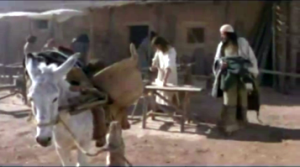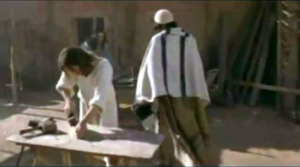Working-Community
Jesus grew up a carpenter, Joseph’s son (Lk 4:22; Mk 6:3). 2nd century churchman Justin Martyr wrote that Jesus “was considered to be the son of Joseph” and that he “was in the habit of working as a carpenter when among men, making plows and yokes…”* According to Luke’s Gospel, when he was about 30 years old, he began his teaching and healing tours (Lk 3:23). The question follows, did Jesus give up his carpenter’s apron?
I was pleased to see the scene from John 7:1-9 in The Gospel of John (2005). It shows Jesus working at carpentry after his ministry began. The images to the right offer a visualization of the setting of Jesus’ life. For example, Jesus probably worked at carpentry outdoors rather than in an enclosed shop.
Though teaching was Jesus’ primary vocation, it was natural for him to continue his trade. In fact, “Rabbis were expected to gain a skilled trade apart from their study (thus Paul was a leather-worker), so that the stratification that divided teacher from manual laborer in Stoic and other circles of the Hellenistic world was not a significant factor in much of Palestine.”** We are not surprised to read about Paul working as a tent-maker at various times, so why not apply that same logic to Jesus’ experience?
* Justin Martyr, Dialogue with Trypho, chapter 88, trans. by Philip Schaff. The rest of the quote states, “making plows and yokes; by which He taught the symbols of righteousness and an active life; but then the Holy Ghost…descended on Him…” Justin sees a contrast in Jesus’ activity (“but then”) when his teaching ministry began, so our question to decide is how much contrast?
** D.A. Carson and Douglas J. Moo, Introduction to the New Testament (Grand Rapids: Zondervan, 2005), 240.

